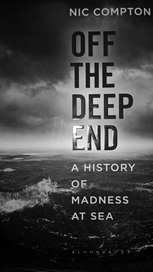
I must go down to the seas again, to the lonely sea and the sky,
And all I ask is a tall ship and a star to steer her by…
So wrote the poet John Masefield characterising a widely held romantic view of seafaring that many of us hold. Off the Deep End is quick to dispel this myth; nothing could be further from the popular view. An arduous, enclosed environment, a lack of privacy and enforced intimacy, monotonous routine, sensory deprivation, constant threat and danger, alcohol misuse, extremes of climate, ferocious discipline and on top of all that misfit colleagues some at least of whom took to seafaring because they simply did not fit into normal society. Was ever there a milieu more designed to precipitate or potentiate mental illness?
The extent of mental breakdown at sea is hard to quantify. Surprisingly large numbers of seafarers unexpectedly disappear overboard never to be found, and continue to do so (at least 2000 per year currently). Accidents happen, but presumably, a significant number of these must be suicide. Historically, sailors behaving oddly or showing signs of mental distress were a detriment to group cohesion, a potential physical threat or plain bad luck and were simply thrown overboard. Despite this it was the Royal Navy who founded the first purpose-built asylum after the Bethlem Hospital in 1818, an indication of the extent of the problem.
Compton's book is a highly entertaining read that recounts innumerable stories of breakdown and insanity, some of which are largely unknown, others which made history. For example, the background story of Vice Admiral Robert FitzRoy, Captain of HMS Beagle and pioneer of scientific weather forecasting, deliberately selecting Charles Darwin for the voyage not for his scientific prowess, rather because from previous experience Fitzroy felt he needed intellectual stimulation and a travelling companion to stop him going insane. He may have survived the voyage but still eventually went on to take his own life. Stories abound of acts of cannibalism among shipwrecked sailors leaving horrific mental scars. Of particular interest are the descriptions of a myriad of illusions and hallucinations that have been recognised by the seafaring community for generations. The story of the Flying Dutchman, a ghost ship of legend is explained by refractive properties of light in particular weather conditions making real objects over the horizon, appear in the air, above the water. To the single-handed racing community who live effectively in a self-imposed solitary confinement, auditory and visual hallucinations appear to be the norm and come as no surprise, as do the voices that come with relentless exposure to the constant white noise of the waves.
The book's final chapter comes with a twist; some of the very risk factors that predispose to mental illness such as the close confinement, physical rigors and exposure to the elements are turned to therapeutic advantage using sail training. This helps rehabilitate disparate groups, ranging from ex-servicemen with post-traumatic stress disorder, delinquent adolescents and patients from the National Health Service with a variety of mental illness. The evidence-based outcomes are positive and one can only hope that these opportunities become more widely available.
This is a book academic as it is entertaining for the study, but also a good holiday read. It should appeal to anyone with a nautical interest; however, the history and extraordinary stories deserve a far wider readership.



eLetters
No eLetters have been published for this article.